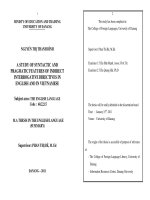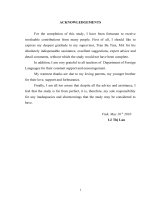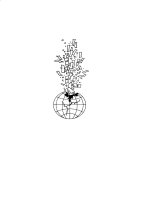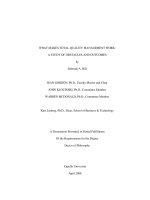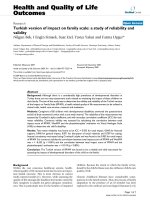What makes Total Quality Management work A study of obstacles and outcomes
Bạn đang xem bản rút gọn của tài liệu. Xem và tải ngay bản đầy đủ của tài liệu tại đây (435.84 KB, 139 trang )
WHAT MAKES TOTAL QUALITY MANAGEMENT WORK:
A STUDY OF OBSTACLES AND OUTCOMES
by
Deborah A. Hill
JEAN GORDON, Ph.D., Faculty Mentor and Chair
JOHN KLOCINSKI, Ph.D., Committee Member
WARREN MCDONALD, Ph.D., Committee Member
Kurt Linberg, Ph.D., Dean, School of Business & Technology
A Dissertation Presented in Partial Fulfillment
Of the Requirements for the Degree
Doctor of Philosophy
Capella University
April 2008
UMI Number: 3303697
3303697
2008
UMI Microform
Copyright
All rights reserved. This microform edition is protected against
unauthorized copying under Title 17, United States Code.
ProQuest Information and Learning Company
300 North Zeeb Road
P.O. Box 1346
Ann Arbor, MI 48106-1346
by ProQuest Information and Learning Company.
ii
Abstract
Data was gathered from a section survey of ASQ members to determine the obstacles
associated with managing a successful quality transformation. The five most significant
barriers to TQM were: (a) management’s compensation was not tied to achieving quality
goals, (b) employees are not trained in quality improvement skills, (c) there are not
adequate resources to effectively employ total quality management, (d) employees are
resistant to change, and (e) employees are not trained in problem identification and
problem solving techniques. Factor analysis on the ratings of the twenty-one barriers to
TQM revealed three underlying constructs: (a) lack of planning for quality, (b) lack of
training on quality, and (c) lack of leadership for quality. These obstacles were found to
be significantly related to specific potential outcomes that can be used to measure TQM
success (or failure). The potential outcomes include frequent turnover of employees,
frequent turnover of management, the cost/benefit ratio of implementing TQM, and
quality improvement results rarely meet expectations. This provides a useful way to
evaluate the significance of obstacles to TQM success, and therefore, provides guidance
and direction for developing strategies for an effective quality transformation.
iii
Table of Contents
List of Tables vi
List of Figures vii
CHAPTER 1. INTRODUCTION 1
Introduction to the Problem 1
Background of the Study 1
Statement of the Problem 2
Purpose of the Study 2
Research Questions 3
Significance of the Study 4
Definition of Terms 4
Assumptions and Limitations 6
Nature of the Study, or Theoretical/Conceptual Framework 6
Organization of the Remainder of the Study 7
CHAPTER 2. LITERATURE REVIEW 8
TQM Defined 8
History of TQM 9
Obstacles to TQM 32
Benefits of TQM 40
How Can TQM Work? 46
CHAPTER 3. METHODOLOGY 56
iv
Population 56
Research Design 57
Sample 61
Instrumentation/Measures 62
Data Collection 63
Data Analysis 63
Validity 64
Reliability 64
Ethical Considerations 65
CHAPTER 4. RESULTS 66
Summary of Research Design and Methodology 66
Characteristics of Respondents 66
Definitions of Quality 68
Product Quality Dimensions 71
Service Quality Dimensions 76
Research Questions 82
Obstacles to TQM Success 82
Correlations of Obstacles with Outcomes 97
CHAPTER 5. DISCUSSION AND CONCLUSIONS 103
Findings and Interpretations 104
Recommendations 112
Suggestions for Future Research 114
Summary and Conclusion 115
v
REFERENCES 117
APPENDIX. SURVEY QUESTIONS 125
vi
List of Tables
Table 1. Eigenvalues and the Total and Cumulative Variance for Each Extracted Factor97
Table 2. Results From the Regression Analyses 100
vii
List of Figures
Figure 1. Size of Organization 67
Figure 2. Type of Organization 67
Figure 3. Quality Defined as Innate Excellence 68
Figure 4. Quality Defined as a Measured Characteristic 69
Figure 5. Quality Defined by Intended Use 70
Figure 6. Quality Defined as Conformance to Standards 70
Figure 7. Quality Defined as Performance at an Acceptable Price 71
Figure 8. Product Quality Dimension-Aesthetics 72
Figure 9. Product Quality Dimension-Conformance 73
Figure 10. Product Quality Dimension-Durability 73
Figure 11. Product Quality Dimension-Features 74
Figure 12. Product Quality Dimension-Perceived Quality 74
Figure 13. Product Quality Dimension-Performance 75
Figure 14. Product Quality Dimension-Reliability 75
Figure 15. Product Quality Dimension-Serviceability 76
Figure 16. Service Quality Dimension-Reliability 77
Figure 17. Service Quality Dimension-Responsiveness 78
Figure 18. Service Quality Dimension-Competence 78
Figure 19. Service Quality Dimension-Access 79
Figure 20. Service Quality Dimension-Courtesy 79
Figure 21. Service Quality Dimension-Communication 80
Figure 22. Service Quality Dimension-Credibility 80
viii
Figure 23. Service Quality Dimension-Security 81
Figure 24. Service Quality Dimension-Knowing the Customer 81
Figure 25. Service Quality Dimension-Tangibles 82
Figure 26. Statement 1-Strategic Plans do not Include Quality Goals. 84
Figure 27. Statement 2-The Best Practices and/or Products of Other Companies are NOT
Benchmarked. 85
Figure 28. Statement 3-There are Excess Layers of Management. 85
Figure 29. Statement 4-Quality is Treated as a Separate Initiative 86
Figure 30. Statement 5-Quality is not Everyone’s Responsibility 86
Figure 31. Statement 6-Employees are NOT Trained in Problem Identification and
Problem Solving Techniques. 87
Figure 32. Statement 7-There is no Joint Planning with Suppliers 87
Figure 33. Statement 8-Quality is not Effectively Measured. 88
Figure 34. Statement 9-Quality is NOT Defined by the Customer 88
Figure 35. Statement 10-Employees are not Trained in Group Discussion and
Communication Techniques. 89
Figure 36. Statement 11-Quality Action Plans are Often Vague 89
Figure 37. Statement 12-The Strategic Plan is NOT Customer Driven 90
Figure 38. Statement 13-Employees are NOT Empowered to Implement Quality
Improvement Efforts 90
Figure 39. Statement 14-There are Inadequate Resources to Effectively Employ Total
Quality Management 91
Figure 40. Statement 15-Cross-Functional Teams are not Employed. 91
Figure 41. Statement 16-Employees and/or Teams are NOT Recognized for
Achievements in Quality Improvement 92
Figure 42. Statement 17-Employees are NOT Trained in Quality Improvement 92
ix
Figure 43. Statement 18-Top Management is NOT Visibly and Explicitly Committed to
Quality 93
Figure 44. Statement 19-Quality Improvement Efforts Rarely Meet Expectations in
Terms of desired results 93
Figure 45. Statement 20-Management’s Compensation is NOT Linked to Achieving
Quality Goals. 94
Figure 46. Statement 21-There is Frequent Turnover of Employees 94
Figure 47. Statement 22-Time Constraints Prohibit Effective Total Quality Management
Implementation. 95
Figure 48. Statement 23-Employees are Resistant to Change. 95
Figure 49. Statement 24-The High Costs of Implementing Total Quality Management
Outweigh the Benefits 96
Figure 50. Statement 25-There is Frequent Turnover of Management. 96
Figure 51. Scree Plot for the Principal Components Analysis 98
1
CHAPTER 1. INTRODUCTION
Introduction to the Problem
Various forms of TQM are being implemented and used today by all types of
organizations. However, as stated by Taylor and Wright (2003a, p. 548), “Many
organizations adopt new managerial innovations such as TQM, yet a smaller number are
able to sustain the success of the innovation.” Also, stated in another article (“Proposing a
Framework for Your TQM Program,” 2002, p. 58), “For the last two decades, TQM has
been seen as a source of competitive advantage…however, the credibility of TQM has
been undermined by the failure of a large proportion of those programs.” There are many
reasons for these failures; however, the top five given in a 2003 study concerning
obstacles to continuous improvement programs were (a) inadequate human resources
development and management, (b) lack of planning for quality, (c) lack of leadership for
quality, (d) inadequate resources for improvement programs, and (e) lack of customer
focus (Sebastianelli & Tamimi, 2003, p. 45). The returns on these programs have been far
below expectations.
Background of the Study
There are many obstacles to continuous improvement programs and there have
been many studies that pursued this topic; however, few have evaluated the relationship
of the obstacles to components of success and failure (Sebastianelli & Tamimi, 2003).
Since so many of these programs have not provided expected returns, it is worthwhile to
find out exactly what the obstacles are, as that will assist companies in the
implementation and the sustaining of continuous improvement initiatives. One study by
2
Hendricks and Singhal (2001, p. 360) stated that, “Firms that implement TQM effectively
must have patience, as the benefits will be realized in the long run. The evidence suggests
that even after effective implementation, it still takes a couple of years before financial
performance starts to improve.”
Statement of the Problem
The problem is that many companies are implementing and using various types of
continuous improvement initiatives, but either the results are far below expectations or
companies are unable to sustain quality management. This study determined the obstacles
to TQM and then established a link between particular measures of perceived TQM
success to show how the quality transformation process can be more efficiently managed
in manufacturing and service organizations.
Purpose of the Study
The purpose of the study was to determine what obstacles are associated with
managing a successful quality transformation and compare them to specific outcomes
that measure TQM success. Twenty five factors were extracted from a study by Sila and
Ebrahimpour (2002) concerning the most commonly extracted TQM factors based on
survey-based research. The factors can be categorized into 21 potential barriers to TQM
and 4 potential outcomes that measure TQM success or failure.
The first objective of the study was to determine, utilizing quantitative analysis,
obstacles to managing the TQM transformation. The second objective was to examine the
relationship between obstacles and different measures of the perceived success (or
3
failure) of TQM (Sebastianelli & Tamimi, 2003). Members of ASQ (American Society
for Quality) in the Raleigh, North Carolina, section were surveyed using a 25-item scale
that lists statements representing 21 potential barriers to TQM and 4 statements
representing potential undesirable outcomes from failed TQM.
These 25 factors were determined by Sila and Ebrahimpour (2002) to be the most
commonly extracted TQM factors from research of 347 survey-based quality
management research articles. Items include employee empowerment, resistance to
change, employee training, resources, strategic planning, and customer focus. Other items
on the scale include benchmarking, joint planning with suppliers, and management
compensation. Also, four items which can be considered potential outcomes of failed
TQM are included: employee turnover, the high cost/benefit ratio of implementing TQM,
management turnover, and perceptions of whether quality improvement results meet
expectations. Factor analysis on the scale items is used to empirically derive obstacles to
TQM. These results and links between obstacles and measures of perceived TQM will
help to provide insight on how to better manage TQM implementations (Sebastianelli &
Tamimi, 2003).
Research Questions
The research questions this study addressed are
1. What obstacles associated with managing the quality transformation are
perceived as real barriers to TQM success for organizations among
members of the Raleigh, North Carolina, section of ASQ?
2. How do these obstacles relate to specific outcomes that measure the
perceived success (or failure) of TQM efforts for organizations among
members of the Raleigh, North Carolina, section of ASQ?
4
Significance of the Study
This study is important because companies that are undertaking various forms of
TQM need to know effective implementation measures and how to sustain the necessary
and appropriate level of quality management. Therefore, the return on the investment of
time and labor must be benchmarked for continuous improvement. With TQM failure
rates high, companies need to see the links between obstacles and potential successful
outcomes. This study can build on existing knowledge to provide more recent
information to assist in implementation and maintenance of TQM and can show
companies how to maximize the benefits derived from TQM. Benefits of TQM are also
explained and illustrated to encourage companies to continue to improve implementation
processes.
Definition of Terms
ASQ. The American Society for Quality is a professional organization that
advances learning, quality improvement, and knowledge exchange to improve business
results and to create better workplaces and communities worldwide. ASQ also
administers the Malcolm Baldrige National Quality Award.
Continuous Improvement. This is the process by which an organization constantly
monitors its processes for areas of improvement. It is a never-ending effort to discover
and eliminate the root causes of problems.
Effective. This means to have an intended or expected effect.
5
Efficient. Efficient means to enhance productivity, that is, less rework, fewer
errors, and optimal use of resources. To improve efficiency, the productivity ratio must
be improved (the input to output ratio must be decreased).
ISO 9000 Series. This denotes a set of international standards for quality
management and quality assurance. The standards were developed to help companies
effectively document the elements necessary to maintain an efficient quality system.
These standards are not specific to any single industry.
Failure. Failure is an event that does not accomplish its intended purpose.
Lean sigma. This process focuses on eliminating non-value-added activities from
the company's processes, including defects. It includes determining root cause and
understanding and determining the effect of variation on the process and product quality.
Malcolm Baldrige National Quality Award (MBNQA). This award is administered
by ASQ and is presented annually to organizations that demonstrate quality and
performance excellence. Three awards may be given each year in each of the following
five categories: manufacturing, service, small business, education, and health care.
Obstacles. These are obstructions that stand in the way of TQM and must be
removed, surmounted, or circumvented.
TQM (Total Quality Management). This is a description of the culture, attitude,
and organization of a company that strives to provide customers with products and
services that satisfy their needs. The culture requires quality in all aspects of the
company's operations, with processes being done right the first time and defects and
waste eradicated from operations.
6
Six Sigma. Six Sigma is a customer-focused methodology that incorporates a
formal process and a variety of tools, including statistical analysis, to reduce the variation
that causes defects.
Success. This is an event that accomplishes its intended purpose.
Assumptions and Limitations
The first assumption is that most TQM programs are not successful. Another
assumption is that ASQ members can speak only to their particular company’s TQM
process and factors. It was assumed that responses will be honest and forthright without
fear of casting the company in question in a poor light. The limitations are that
perceptions are from members of the Raleigh section of ASQ only and may not be
generalizable to other parts of the country or world.
Nature of the Study, or Theoretical/Conceptual Framework
This study used quantitative methodology to analyze the results. According to
Robson (2002), with quantitative or fixed designs, links from research to theory are
straightforward and theory driven. Robson believes that the phenomenon under study is
already thoroughly and conceptually understood before the study is undertaken.
Quantitative data includes all values and measurements of variables and provides validity
based on the accuracy of results (Robson, 2002). Therefore, since this study determined
obstacles and how they relate, the study is solidly fixed and the components have already
been determined. Additionally, the quantitative approach is the best way to determine
7
how reliable and valid the results are and the best way to answer and measure the
research questions.
Organization of the Remainder of the Study
Chapter 2 reviews the history of TQM and discusses what the current literature
states concerning benefits and obstacles to TQM. Chapter 3 details the methodology and
conceptual framework of this study. Chapter 4 discusses the results of the survey and
chapter 5 addresses the findings and interpretation of the results, as well as
recommendations and opportunities for further research.
8
CHAPTER 2. LITERATURE REVIEW
TQM Defined
TQM has been defined in many different ways. The definition of TQM according
to the International Standard ISO 8402, Quality Management and Quality Assurance-
Terminology, is as follows (Ljungstrom & Klefsjo, 2002, p. 622): “Management
approach of an organization, centered on quality, based on the participation of all its
members and aiming at long-term success through customer satisfaction, and benefits to
all members of the organization and to society.” Another definition states, “TQM seeks
continuous improvement in the quality of all processes, people, products, and services of
an organization” (Temtime & Solomon, 2002, p. 181). TQM is also “a systems approach
to management that aims to enhance value to customers by designing and continually
improving organizational processes and systems” (Kartha, 2004, p. 331). The emphasis is
on employee involvement and empowerment along with customers and customer
satisfaction as the focal point. The tenets of TQM are continuous improvement, top
management leadership commitment to the goal of customer satisfaction, employee
empowerment, and customer focus (Ugboro & Obeng, 2000, p. 248).
Even though many think that TQM is old news, many of the new continuous
improvement initiatives are based on TQM philosophies. TQM encompasses a number of
different initiatives. For example, Six Sigma, which is popular today, is a methodology
within TQM, not an alternative to it (Klefsjo, Wiklund, & Edgeman, 2001). Lean Sigma
is another methodology that is widely used today that is included within TQM. TQM also
9
includes initiatives such as ISO 9000 and the Malcolm Baldrige National Quality Award
(MBNQA).
TQM is often thought of as either a terrific quality marvel or tragic quality
malpractice. It depends on several factors, such as to what type of organization the TQM
concepts are applied and what definition of TQM is used (Bergquist, Fredriksson, &
Svensson, 2005, p. 318). Unfortunately, international research holds several different
descriptions and unclear definitions of TQM, which is why ISO 9000 and MBNQA were
developed: to set standards and procedures for quality. However, because of its well
developed set of principles and key elements, many of which are replicated in other
approaches, TQM can be considered the foundation upon which other improvement
approaches are based (Wiele, Iwaarden, Dale, & Williams, 2006, p. 368).
History of TQM
TQM was introduced in the United States in the early to mid-1980s, primarily as a
result of severe competition from Japanese companies (Prajogo, 2005). At that time,
American business faltered and productivity decreased, quality of products and services
deteriorated, and the trade deficit began to rise (Reis & Pena, 2001). Although research
has different opinions on exactly who started TQM, seven seminal quality authors surface
repeatedly: Philip B. Crosby, W. Edwards Deming, Armand V. Feigenbaum, Kaoru
Ishikawa, Joseph M. Juran, Walter A. Shewhart, and Genichi Taguchi. Each expert
devised his own unique plan of action for success; however, Deming and Juran are
credited with starting quality initiatives in the United States after returning from Japan in
the late 1950s. Deming and Juran assisted in reconstructing Japanese industry after WWII
10
(Goldman, 2005). Their techniques improved the quality of Japanese-made products to a
level that was better than similar products produced in the United States in the late 1970s
and early 1980s (Goldman, 2005). The TQM movement took root in the United States
with the airing of a NBC televised program in 1980 entitled "If Japan Can, Why Can't
We?" which revealed Deming's key role in the development of Japanese quality (Reis &
Pena, 2001, p. 669). Since then, TQM concepts have been implemented in many
companies in the United States and abroad. However, TQM began by utilizing the works
of the seven seminal authors, and it has now led to quality programs in the United States
such as the Malcolm Baldrige Award Program, ISO 9000, Six Sigma, and Lean Sigma.
Listed below, in alphabetical order, are the philosophies of the seven seminal quality
authors from which TQM evolved.
Crosby
Crosby (1926-2001) is well-known for his "Quality is free" concept and his zero-
defects concepts. In his book, Quality is Free, Crosby stated (1979, p.1), "Quality is free.
It's not a gift, but is free. What costs money are the unquality things—all the actions that
involve not doing jobs right the first time." Crosby’s philosophy can be described best by
his four absolutes of quality management (1989, p. 50):
1. Quality is defined as conformance to requirements, not goodness.
2. Quality is achieved through prevention, not appraisal.
3. The quality performance standard is zero defects, not acceptable quality
levels.
4. Quality is measured by the price of nonconformance, not indexes.
11
These absolutes of quality are encompassed in Crosby's 14-step guidelines for
implementing quality (1979, pp. 132-139; 1989, pp. 106-107):
1. Management commitment: the willingness to give away something you
cherish, something very personal, in order to improve the quality of other
people's lives.
2. Quality improvement team: the "health care" group that is charged with
supervising and coordinating the surgery, recovery, and wellness process
in an organization.
3. Quality measurement: determining if the various "life support systems and
procedures" are operating to the required results.
4. Cost of quality evaluation: reveals the expense and inconvenience of doing
things wrong.
5. Quality awareness: communicating continually in order to let everyone
know they are on the same track.
6. Corrective action: identifying, curing, and then preventing the diseases
that impair the enjoyment of life, be it personal or business.
7. Establish an ad hoc committee for the zero defects program-arranging for
the day-commencement day, when management will stand up in front of
everyone and declare that they have been converted.
8. Supervisor training: employee education involves building a base for
comprehension and implementation through a common language and the
application of special skills.
9. Zero defects day: the day when everyone gets together and celebrates their
commitment to quality.
10. Goal setting: describing the specific achievements that each individual is
going to accomplish.
11. Error cause removal: a system of pinpointing and eliminating the obstacles
to zero defects.
12. Recognition-acknowledgement: saying "thank you" to those who earn and
deserve it.
12
13. Quality councils: meetings of those responsible for an organization's
wellness.
14. Do it over again: to quote Albert Schweitzer, "Example is not the main
thing in influencing others, it is the only thing."
Crosby (1984, pp. 53-54) also wrote about five characteristics of companies that
do not improve much, even though they seem determined:
1. The effort is called a program rather than a process. This makes people
think that it is short-term and will be replaced by something else.
2. All effort is aimed at the lower level of the organization.
3. The quality control people are cynical and believe that there will always
be defects and it is not possible to do things right the first time.
4. Training material is created by the training function. The concepts of
quality improvement and actions required to cause it are very subtle and
require comprehension that come from experience, not from teaching
ideas that caused the problem in the first place.
5. Management is impatient for results. As soon as management hears about
the cost of quality, they want an immediate reduction, which results in
short-range actions.
Crosby (2000) developed a reliable organization grid to help organizations
determine where they stand with respect to quality. Included are the four essential
components that make an organization reliable: policy, education, requirements, and
insistence. Policy is what management requires: work done correctly, that is, zero defects.
Education is used to give everyone a common language and tools for quality.
Requirements are ways in which the needs of the customers are defined. Insistence is
requiring integrity in everything. Crosby (2000, p. 720) believed that using this grid can
help create an organization that is both reliable in its products or services, and useful by
13
providing a product or service with which customers are happy and willing to pay to
receive.
According to Crosby (1979, p. 139), the typical quality initiative takes 12 to 18
months to fully implement. By that time, turnover and changing business situations will
have wiped out much of the education effort. Therefore, the program is never over;
repetition makes the program perpetual. Quality must become engrained in the
organization or it will never happen (Crosby, 1979, p. 139). According to Crosby, there
are three phases of change (1989, p. 15): (a) developing conviction, (b) commitment, and
(c) conversion. Once converted, there is no temptation to take shortcuts or go back to
destructive ways; the converted stay converted (1989, p. 16). Therefore, if top
management is not committed and converted to the idea of quality, quality improvement
initiatives fail.
Deming
Deming (1900-1993) was well recognized for his work with Japan. His
background is as a statistician. He is well-known for his 14 points of management and the
Plan-Do-Check-Act (PDCA) Cycle that is still used today. In 1950, Deming helped to
transform Japan before the United States was willing to change. A chain reaction to
improve quality was developed that was on the blackboard of every meeting with top
management in Japan from July 1950 onward (Deming, 1986, p. 3). This quality chain
reaction had the following impacts (1986, p. 3):
1. Costs decrease because of less rework, fewer mistakes, fewer delays, snags;
better use of machine-time and materials.
2. Productivity improves.
14
3. Capture the market with better quality and lower price.
4. Stay in business.
5. Provide jobs and more jobs.
According to Deming, once management in Japan adopted the chain reaction,
everyone there from 1950 onward had one common aim; namely, quality (1986, p. 3).
Also, in 1950, Deming created the chart, Production Viewed as a System (1986, p. 4).
This chart showed that improvement of quality envelopes the entire production line, from
incoming materials to the consumer, as well as redesign of product and service for the
future. Deming believed that the consumer is the most important part of the production
line and that quality should be aimed at the needs of the consumer, present and future
(1986, p. 5).
After these were used in Japan, then Deming developed his 14 Points for
Management, which according to Deming "are a signal that management intend to stay in
business and aim to protect investors and jobs" (1986, p. 23). Listed below are Deming’s
14 Points for Management (1986, p. 23):
1. Create constancy of purpose toward improvement of product and service,
with the aim to become competitive and to stay in business and to provide
jobs.
2. Adopt the new philosophy. We are in a new economic age. Western
management must awaken to the challenge, must learn their
responsibilities, and take on leadership for change.
3. Cease dependence on inspection to achieve quality. Eliminate the need for
inspection on a mass basis by building quality into the product in the first
place.
4. End the practice of awarding business on the basis of price tag. Instead,
minimize total cost. Move toward a single supplier for any one item, on a
long-term relationship of loyalty and trust.
15
5. Improve constantly and forever the system of production and service, to
improve quality and productivity, and thus constantly decrease costs.
6. Institute training on the job.
7. Institute leadership. The aim of supervision should be to help people and
machines and gadgets do a better job. Supervision of management is in
need of overhaul, as well as supervision of production workers.
8. Drive out fear, so that everyone may work effectively for the company.
9. Break down barriers between departments. People in research, design,
sales, and production must work as a team to foresee problems of
production and in use that may be encountered with the product or service.
10. Eliminate slogans, exhortations, and targets for the work force asking for
zero defects and new levels of productivity. Such exhortations only create
adversarial relationships, as the bulk of the causes of low quality and low
productivity belong to the system and thus lie beyond the power of the
work force.
11. a. Eliminate work standards (quotas) on the factory floor. Substitute
leadership.
b. Eliminate management by objective. Eliminate management by
numbers, numerical goals. Substitute leadership.
12. a. Remove barriers that rob the hourly worker of his right to pride of
workmanship. The responsibility of supervisors must be changed from
sheer numbers to quality.
b. Remove barriers that rob people in management and in engineering of
their right to pride of workmanship. This means abolishment of the
annual of merit rating and or management by objective.
13. Institute a vigorous program of education and self-improvement.
14. Put everyone in the company to work to accomplish the transformation.
The transformation is everybody's job.



